International Women's Day
International Women's Day (IWD) is celebrated on the 8th of March every year around the world.[3] It is a focal point in the movement for women's rights.
| International Women's Day | |
|---|---|
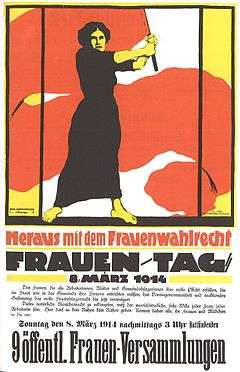 German poster for International Women's Day, March 8, 1914.[lower-alpha 1] This poster was banned in the German Empire.[2] | |
| Observed by | Worldwide |
| Type | International |
| Significance |
|
| Date | March 8 |
| Next time | March 8, 2021 |
| Frequency | Annual |
| Related to | |
After the Socialist Party of America organized a Women's Day in New York City on February 28, 1909, German delegates Clara Zetkin, Käte Duncker, Paula Thiede and others proposed at the 1910 International Socialist Woman's Conference that "a special Women's Day" be organized annually.[4] After women gained suffrage in Soviet Russia in 1917, March 8 became a national holiday there.[5] The day was then predominantly celebrated by the socialist movement and communist countries until it was adopted by the feminist movement in about 1967. The United Nations began celebrating the day in 1977.[6]
Commemoration of International Women's Day today ranges from being a public holiday in some countries to being largely ignored elsewhere.[7] In some places, it is a day of protest; in others, it is a day that celebrates womanhood.[8]
History
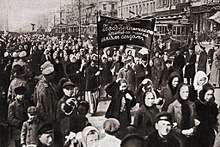


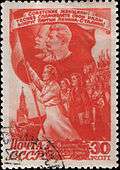
.jpg)
.jpg)
The earliest Women's Day observance, called "National Woman's Day,"[9] was held on February 28, 1909, in New York City, organized by the Socialist Party of America[10] at the suggestion of activist Theresa Malkiel.[11] There have been claims that the day was commemorating a protest by women garment workers in New York on March 8, 1857, but researchers Kandel and Picq have described this as a myth created to "detach International Women's Day from its Soviet history in order to give it a more international origin".[12][13][14]
In August 1910, an International Socialist Women's Conference was organized to precede the general meeting of the Socialist Second International in Copenhagen, Denmark.[15] Inspired in part by the American socialists, German delegates Clara Zetkin, Käte Duncker, Paula Thiede and others proposed the establishment of an annual "Women's Day", although no date was specified at that conference.[4][12][16] Delegates (100 women from 17 countries) agreed with the idea as a strategy to promote equal rights including suffrage for women.[17]
The following year on March 19, 1911, IWD (international women's day) was marked for the first time, by over a million people in Austria, Denmark, Germany and Switzerland.[10] In the Austro-Hungarian Empire alone, there were 300 demonstrations.[12] In Vienna, women paraded on the Ringstrasse and carried banners honouring the martyrs of the Paris Commune.[12] Women demanded that they be given the right to vote and to hold public office. They also protested against employment sex discrimination.[3]
The Americans continued to celebrate National Women's Day on the last Sunday in February.[12]

In 1913 Russian women observed their first International Women's Day on the last Saturday in February (by the Julian calendar then used in Russia).[18]
In 1914, International Women's Day was held on March 8 in Germany, possibly because that day was a Sunday, and now it is always held on March 8 in all countries.[18] The 1914 observance of the Day in Germany was dedicated to women's right to vote, which German women did not win until 1918.[18][19]
In London there was a march from Bow to Trafalgar Square in support of women's suffrage on March 8, 1914. Activist Sylvia Pankhurst was arrested in front of Charing Cross station on her way to speak in Trafalgar Square.[20]
On March 8, 1917, on the Gregorian calendar, in the capital of the Russian Empire, Petrograd, women textile workers began a demonstration, covering the whole city. This marked the beginning of the February Revolution, which alongside the October Revolution made up the Russian Revolution.[3][21] Women in Saint Petersburg went on strike that day for "Bread and Peace" – demanding the end of World War I, an end to Russian food shortages, and the end of czarism.[18] Revolutionary leader Leon Trotsky wrote, "23 February (8th March) was International Woman's Day and meetings and actions were foreseen. But we did not imagine that this 'Women's Day' would inaugurate the revolution. Revolutionary actions were foreseen but without date. But in the morning, despite the orders to the contrary, textile workers left their work in several factories and sent delegates to ask for support of the strike… which led to mass strike... all went out into the streets."[18] Seven days later, Tsar Nicholas II abdicated, and the provisional Government granted women the right to vote.[10]
Following the October Revolution, the Bolshevik Alexandra Kollontai and Vladimir Lenin made it an official holiday in the Soviet Union, but it was a working day until 1965. On May 8, 1965, by the decree of the USSR Presidium of the Supreme Soviet International Women's Day was declared a non-working day in the USSR "in commemoration of the outstanding merits of Soviet women in communistic construction, in the defense of their Fatherland during the Great Patriotic War, in their heroism and selflessness at the front and in the rear, and also marking the great contribution of women to strengthening friendship between peoples, and the struggle for peace. But still, women's day must be celebrated as are other holidays."
After its official adoption in Soviet Russia following the Revolution in 1917, the holiday was predominantly celebrated in communist countries and by the communist movement worldwide. Communist leader Dolores Ibárruri led a women's march in Madrid in 1936 on the eve of the Spanish Civil War.[12]
It was commemorated by the communists in China from 1922.[12] In 1927, in the Chinese city of Guangzhou, there was a march of 25,000 women and male supporters, including representatives of the Kuomintang, the YWCA, and labor organizations.[22] After the founding of the People's Republic of China on October 1, 1949, the State Council proclaimed on December 23 that March 8 would be made an official holiday with women in China given a half-day off.[23]
The day remained predominantly a communist holiday until about 1967 when it was taken up by second-wave feminists.[12] The day re-emerged as a day of activism, being sometimes known in Europe as the "Women's International Day of Struggle". In the 1970s and 1980s, women's groups were joined by leftists and labor organizations in calling for equal pay, equal economic opportunity, equal legal rights, reproductive rights, subsidized child care, and the prevention of violence against women.[24][25]
The United Nations began celebrating International Women's Day in the International Women's Year, 1975. In 1977, the United Nations General Assembly invited member states to proclaim March 8 as the UN Day for women's rights and world peace.[26]
International Women's Day sparked violence in Tehran, Iran on March 4, 2007, when police beat hundreds of men and women who were planning a rally. (A previous rally for the occasion was held in Tehran in 2003.)[27] Police arrested dozens of women and some were released after several days of solitary confinement and interrogation.[28] Shadi Sadr, Mahbubeh Abbasgholizadeh and several more community activists were released on March 19, 2007, ending a fifteen-day hunger strike.[29]
In the twenty–first century, in the West, the day was increasingly sponsored by major corporations and used to promote feel–good messages, rather than radical social reforms.[30] In 2009, the British marketing firm, Aurora Ventures, set up a "International Women's Day" website with corporate sponsorship.[31][32] The website began to promote hashtags as themes for the day, which became used internationally.[33] The day was commemorated by business breakfasts and social media communications that were reminiscent of Mother's Day greetings.[30][24]
Yearly commemorations
IWD 2010
On the occasion of 2010 International Women's Day the International Committee of the Red Cross (ICRC) drew attention to the hardships displaced women endure. The displacement of populations is one of the gravest consequences of today's armed conflicts. It affects women in a host of ways.[34]


IWD 2011
Though the celebration in the West was low-key, events took place in more than 100 countries[7] on March 8, 2011, to commemorate the 100th anniversary of International Women's Day.[35] In the United States, President Barack Obama proclaimed March 2011 to be "Women's History Month", calling Americans to mark IWD by reflecting on "the extraordinary accomplishments of women" in shaping the country's history.[7] Secretary of State Hillary Clinton launched the "100 Women Initiative: Empowering Women and Girls through International Exchanges", on the eve of IWD.[36] In the run-up to 2011 International Women's Day, the Red Cross called on States and other entities not to relent in their efforts to prevent rape and other forms of sexual violence that harm the lives and dignity of countless women in conflict zones around the world every year.[37]
Australia issued an IWD 100th anniversary commemorative 20-cent coin.
In Egypt, in Tahrir Square, Cairo, hundreds of men came out not to support, but to harass the women who came out to stand up for their rights as the police and military stood by watching, doing nothing to stop the crowds of men.[38]
IWD 2012
Oxfam America invited people to celebrate inspiring women in their lives by sending a free International Women's Day e-Card or honoring a woman whose efforts had made a difference in the fight against hunger and poverty with Oxfam's International Women's Day award.[39]
On the occasion of International Women's Day 2012, the ICRC called for more action to help the mothers and wives of people who have gone missing during armed conflict. The vast majority of people who go missing in connection with conflict are men. As well as the anguish of not knowing what has happened to the missing husband or son, many of these women face economic and practical difficulties. The ICRC underlined the duty of parties to this conflict to search for the missing and provide information to the families.[40]
IWD 2013
The International Committee of the Red Cross (ICRC) drew attention to the plight of women in prison.[41]
IWD 2014
American singer Beyoncé also posted an International Women's Day video to her YouTube account. Throughout the video, her song "***Flawless" plays, which includes a portion of the "We Should All Be Feminists" speech given by author Chimamanda Ngozi Adichie.[42]
IWD 2015
Governments and activists around the world commemorated the 20th anniversary year of the Beijing Declaration and Platform for Action, an historic roadmap that set the agenda for realizing women's rights.[43]
IWD 2016
The President of India, Shri Pranab Mukherjee said: "On the occasion of International Women's Day, I extend warm greetings and good wishes to the women of India and thank them for their contributions over the years in the building of our nation."[44] The ministry of women and child development announced the setting up of four more one-stop crisis centers on March 8, in addition to the eight already functioning across the country.[45] Ahead of Women's Day, the national carrier Air India operated what it claimed to be the world's longest non-stop flight where the entire flight operations were handled by women, as part of International Women's Day celebrations. The flight, from Delhi to San Francisco, covered a distance of around 14,500 kilometers in around 17 hours.[46]
IWD 2017
In a message in support of International Women's Day, the UN Secretary-General António Guterres commented on how women's rights were being "reduced, restricted and reversed". With men still in leadership positions and a widening economic gender gap, he called for change "by empowering women at all levels, enabling their voices to be heard and giving them control over their own lives and over the future of our world".[47]
IWD 2019
The UN theme for International Women's Day was: 'Think equal, build smart, innovate for change'. The focus of the theme was on innovative ways in which to advance gender equality and the empowerment of women, particularly in the areas of social protection systems, access to public services and sustainable infrastructure.[48]
The federal state of Berlin marked International Women's Day as a public holiday for the first time.
IWD 2020
.jpg)
The UN theme for International Women's Day was: 'I am Generation Equality': Realizing Women's Rights'.[49] Despite the COVID-19 pandemic, street marches occurred in London, Paris, Madrid, Brussels, Moscow and other European cities.[50][51][52][53] The Aurat March in Islamabad was marred by attacks from stone throwers, after a failed attempt to have it banned as un-Islamic. In Bishkek, the capital of Kyrgyzstan, police detained dozens of marchers shortly after masked men reportedly attacked the march.[50]
| Wikispore has a related page: Event:International Women's Day 2020 |
Around the world
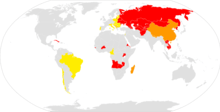
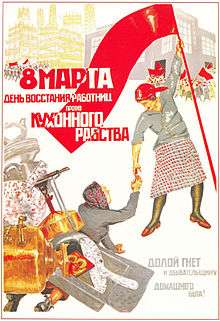
The day is an official holiday in Afghanistan,[54] Angola, Armenia,[55] Azerbaijan,[56][57] Belarus,[58] Burkina Faso,[59] Cambodia,[60] China (for women only),[61] Cuba,[62] Georgia,[63] Guinea-Bissau, Eritrea, Kazakhstan,[64] Kyrgyzstan,[65] Laos,[66] Madagascar (for women only),[67] Moldova,[68] Mongolia,[69] Nepal, Russia, Tajikistan, Turkmenistan, Uganda, Ukraine,[70] Uzbekistan,[71] Vietnam,[72] and Zambia.[73]
In some countries, such as Cameroon,[74] Croatia,[75] Romania,[76] Bosnia and Herzegovina,[77] Bulgaria[78] and Chile,[79] the day is not a public holiday, but is widely observed nonetheless. On this day it is customary for men to give the women in their lives – friends, mothers, wives, girlfriends, daughters, colleagues, etc. – flowers and small gifts (although to many this seems cloyingly old-fashioned and rather to miss the point). In some countries (such as Bulgaria and Romania) it is also observed as an equivalent of Mother's Day, where children also give small presents to their mothers and grandmothers.[76] In Russia, the day has lost all political context through the time, becoming simply a day to honor women and feminine beauty.[80]
In the Czechoslovak Socialist Republic, huge Soviet-style celebrations were held annually. After the fall of Communism, the holiday, generally considered to be one of the major symbols of the old regime, fell into obscurity. International Women's Day was re-established as an official "important day" by the Parliament of the Czech Republic in 2004[81] on the proposal of the Social Democrats and Communists. This has provoked some controversy as a large part of the public as well as the political right see the holiday as a relic of the nation's Communist past.[81]
The day is widely celebrated in France, as Journée internationale des femmes. To celebrate the day in Italy, men give yellow mimosas to women.[82][83] Communist politician Teresa Mattei chose the mimosa in 1946 as the symbol of IWD in Italy because she felt that the French symbols of the day, violets and lily-of-the-valley, were too scarce and expensive to be used effectively in Italy.[84]
In the United States, actress and human rights activist Beata Pozniak worked with the Mayor of Los Angeles and the Governor of California to lobby members of the US Congress to propose official recognition of the holiday. In February 1994, by Beata Pozniak suggestion, the H. J. Res. 316 was introduced by Rep. Maxine Waters, along with 79 cosponsors, in an attempt to officially recognize March 8 of that year as International Women's Day. The bill was subsequently referred to, and remained in, the House Committee on Post Office and Civil Service. No vote of either house of Congress was achieved on this piece of legislation.[85]
As of 2019, International Women's Day will also be celebrated as a public holiday in the federal state of Berlin, Germany[86]
In Pakistan, the Aurat March has challenged misogyny since 2018.[87]
Official UN themes
| Year | UN Theme[88] |
|---|---|
| 1996 | Celebrating the Past, Planning for the Future |
| 1997 | Women and the Peace Table |
| 1998 | Women and Human Rights |
| 1999 | World Free of Violence Against Women |
| 2000 | Women Uniting for Peace |
| 2001 | Women and Peace: Women Managing Conflicts |
| 2002 | Afghan Women Today: Realities and Opportunities |
| 2003 | Gender Equality and the Millennium Development Goals |
| 2004 | Women and HIV/AIDS |
| 2005 | Gender Equality Beyond 2005; Building a More Secure Future |
| 2006 | Women in Decision-making |
| 2007 | Ending Impunity for Violence Against Women and Girls |
| 2008 | Investing in Women and Girls |
| 2009 | Women and Men United to End Violence Against Women and Girls |
| 2010 | Equal Rights, Equal Opportunities: Progress for All |
| 2011 | Equal Access to Education, Training, and Science and Technology: Pathway to Decent Work for Women |
| 2012 | Empower Rural Women, End Poverty and Hunger |
| 2013 | A Promise is a Promise: Time for Action to End Violence Against Women |
| 2014 | Equality for Women is Progress for All |
| 2015 | Empowering Women, Empowering Humanity: Picture it! |
| 2016 | Planet 50-50 by 2030: Step It Up for Gender Equality |
| 2017 | Women in the Changing World of Work: Planet 50-50 by 2030 |
| 2018 | Time is Now: Rural and urban activists transforming women's lives |
| 2019 | Think Equal, Build Smart, Innovate for Change |
| 2020 | "I am Generation Equality: Realizing Women’s Rights ” |
See also
- Communist Women's International
- Day Without a Woman
- International Day for the Elimination of Violence against Women
- International Day of the Girl Child
- International Men's Day
- International Non-Binary People's Day
- List of uprisings led by women
- UN Women
- Women's empowerment
- Women's March (disambiguation)
- Women's strike (disambiguation)
- Aurat March (in Pakistan)
- International Day of Women and Girls in Science (February 11)
Other holidays honoring women
- National Women's Day (South Africa) (August 9)
- Susan B. Anthony Day (February 15, US)
- Rosa Parks Day (February 4 / December 1, US)
- National Girls and Women in Sports Day (one day first week of February, US)
- Harriet Tubman Day (March 10, US)
- Kartini Day (April 21, Indonesia)
- Helen Keller Day (June 27, US)
- Women's Equality Day (August 26, US)
- Mother's Day
- Nupi Lan Day (December 12, India)
- Hinamatsuri (March 3, Japan, though it is for girls)
Notes
- English : "Give Us Women's Suffrage. Women's Day, March 8, 1914. Until now, prejudice and reactionary attitudes have denied full civic rights to women, who as workers, mothers, and citizens wholly fulfill their duty, who must pay their taxes to the state as well as the municipality. Fighting for this natural human right must be the firm, unwavering intention of every woman, every female worker. In this, no pause for rest, no respite is allowed. Come all, you women and girls, to the 9th public women's assembly on Sunday, March 8, 1914, at 3 pm."[1]
References
- "Give Us Women's Suffrage (March 1914)". German History in Documents and Images. Retrieved January 26, 2014.
- Frencia, Cintia; Gaido, Daniel (March 8, 2017). "The Socialist Origins of International Women's Day". Jacobin.
- "UN WomenWatch: International Women's Day –". UN.org. Retrieved February 21, 2013.
- ""International Socialist Congress, 1910; Second International Conference of Socialist Women". p. 21. Retrieved March 7, 2020.
- Cheah, S. G. (March 8, 2020). "Women In Red: The Surprising History Of International Women's Day". Evie Magazine. Archived from the original on March 9, 2020. Retrieved March 9, 2020.
statement made by Vladimir Lenin, who presided over the first official March 8th celebration of this day in Russia: “For under capitalism the female half of the human race is doubly oppressed. The working woman and the peasant woman are oppressed by capital [...] “The second and most important step is the abolition of the private ownership of land and the factories. This and this alone opens up the way towards a complete and actual emancipation of woman
- "International Women's Day, 8 March". www.un.org. Retrieved March 7, 2020.
- Sindelar, Daisy. "Women's Day Largely Forgotten in West, Where It Got Its Start". Radio Free Europe. Radio Free Europe. Retrieved March 8, 2011.
- "International Women's Day – March 8, 2020". National Today. Retrieved March 6, 2020.
- "International Women's Day History | International Women's Day | The University of Chicago". iwd.uchicago.edu. Archived from the original on April 8, 2017. Retrieved April 7, 2017.
- "United Nations page on the background of the IWD". Un.org. Retrieved March 8, 2012.
- Miller, Sally M. (December 1978). "From Sweatshop Worker to Labor Leader: Theresa Malkiel, A Case Study". American Jewish History. 68 (2): 197. JSTOR 23881894.
- Kaplan, Temma (1985). "On the Socialist Origins of International Women's Day". Feminist Studies. 11 (1): 163–171. doi:10.2307/3180144. JSTOR 3180144.
- Kandel, Liliane; Picq, Françoise (1982). "Le Mythe des origines à propos de la journée internationale des femmes". La Revue d'en face. 12: 67–80. Archived from the original on September 27, 2013.
- Zophy, Angela Howard (1991). Handbook of American Women's History. Garland. p. 187. ISBN 0-8240-8744-5.
- Rochelle Goldberg Ruthchild, "From West to East: International Women’s Day, the First Decade”, Aspasia: The International Yearbook of Central, Eastern, and Southeastern European Women's and Gender History, vol. 6 (2012): 1–24.
- "History of International Women's Day". United Nations. Retrieved May 26, 2012.
- "About International Women's Day". Internationalwomensday.com. March 8, 1917. Retrieved February 26, 2016.
- "8th of March – International woman's day: in search of lost memory". Archived from the original on March 13, 2011. Retrieved March 14, 2014.
- "Women's Suffrage". Inter-Parliamentary Union. Retrieved January 26, 2014.
- "Suffragist Disorders". The Times. March 9, 1914. Retrieved May 9, 2014.
- "February Revolution". RIA Novosti. Retrieved March 7, 2017.
- Yau Tsit Law (June–July 1927). "International Women's Day in Canton March 8, 1927". News Bulletin (Institute of Pacific Relations).
- "Anniversaries of important events". China Factfile. Chinese Government. Retrieved August 28, 2011.
- Søland, Birgitte (March 4, 2019). "International Women's Day". Origins.
- Gillis, Elizabeth (January 20, 2017). "Ahead Of The Boston Women's March, A Look Back 47 Years Ago". WBUR.
- "International Women's Day". United Nations.
- "Iranian Women Rally to Demand Equal Social, Political Rights" Index-Journal (March 9, 2003): 9. via Newspapers.com

- Harrison, Frances (March 8, 2007). "Middle East | Iranian women struggle for equality". BBC News. Retrieved March 8, 2012.
- "Iran: Release Women's Rights Advocates | Human Rights Watch". Hrw.org. March 8, 2007. Archived from the original on November 2, 2008. Retrieved March 8, 2012.
- Blau, Annika (March 8, 2019). "International Women's Day went from bloody revolution to corporate breakfasts". ABC.
- "International Women's Day".
- "Aurora Ventures: Our Work".
- Liddle, Celeste (March 8, 2018). "International Women's Day is a call to action, not a branding opportunity". SBS.
- "Women and displacement: strength in adversity". International Committee of the Red Cross. March 2, 2010. Retrieved March 8, 2012.
- Pasha, Masroor Afzal. "To commemorate 100th International Women's Day". Daily Times. Archived from the original on October 25, 2012. Retrieved March 8, 2011.
- McKellogg, JulieAnn. "Clinton Launches 100th Anniversary of International Women's Day". VOA News. voanews.com. Retrieved March 8, 2011.
- "International Women's Day: the fight against sexual violence must not falter". Icrc.org. Retrieved March 8, 2012.
- Al-Shalchi, Hadeel (March 8, 2011). "Egyptian women's rights protest marred by hecklers". The Washington Post. AP. Retrieved March 8, 2015.
- "International Women's Day Celebration". Actfast.oxfamamerica.org. Retrieved March 8, 2012.
- Helping women take matters into their own hands International Committee of the Red Cross
- "The forgotten plight of women behind bars". ICRC. Retrieved March 8, 2013.
- Eliana Dockterman. "Beyoncé: Lessons in Modern Feminism". TIME.com. Retrieved March 9, 2016.
- "The Beijing Platform for Action, inspiration then and now | Beijing+20 campaign". UN Women. Retrieved February 11, 2015.
- "President of Indias message on the eve of International Womens Day". business-standard.com. Delhi. March 7, 2016.
- "Women's Day gift: Govt to come with 4 one-stop crisis centres". The Times of India. March 7, 2016.
- PTI (March 7, 2016). "Ahead of Women's Day, Air India operates 'world's longest all-women flight'". The Indian Express.
- "UN Secretary-General's Message for International Women's Day". UN. March 6, 2017. Retrieved March 8, 2017.
- "International Women's Day 2019: Think equal, build smart, innovate for change". unwomen.org. UN Women. October 16, 2018. Retrieved March 8, 2019.
- "International Women's Day 2020". UNWomen.
- "International Women's Day: Marchers around the world call for equality". BBC News. March 8, 2020.
- "Thousands March in Spain on Women's Day Despite Coronavirus Fears". US News. Reuters. March 8, 2020.
- "International Women's Day Marked Across the World". VOA News. March 8, 2020.
- "International Women's Day 2020 around the world - in pictures". The Guardian. March 8, 2020.
- Saul, Heather (March 8, 2018). "International Women's Day around the world: from sex worker strikes to women-only public holidays". News The Essential Daily Briefing. Retrieved March 20, 2018.
- "Armenian Holidays – Armenia Information". Armeniainfo.am. July 5, 1995. Archived from the original on May 12, 2012. Retrieved March 8, 2012.
- Azerbaijan.msntour.az Archived September 12, 2008, at the Wayback Machine
- "Public Holidays in Azerbaijan – International Women's Day". advantour.com. Retrieved March 9, 2016.
- (in Russian) President's decree on public holidays in Belarus – 1998
- Coordination Team (May 22, 2011). "Taking International Women's Day Seriously in Burkina Faso". capacity4dev.ec.europa.eu. Development and Cooperation – EuropeAid. Retrieved March 8, 2014.
- "2007 Cambodia Public Holiday – Cambodia e-Visa Blog". Cambodiaevisa.com. August 4, 2007. Archived from the original on April 25, 2012. Retrieved March 8, 2012.
- "Public holidays in the People's Republic of China". Sg2.mofcom.gov.cn. January 9, 2008. Retrieved March 8, 2013.
- "Ministerio de Relaciones Exteriores de Cuba". Cubaminrex.cu. March 8, 2011. Archived from the original on March 16, 2012. Retrieved March 8, 2012.
- "დღესასწაულები". Embassy.mfa.gov.ge. Archived from the original on March 6, 2012. Retrieved March 8, 2012.
- "Holidays and weekends in the Republic of Kazakhstan in 2014 year". E.gov.kz. Retrieved March 7, 2014.
- "Kyrgyz and American Holidays (In Russian)". US Embassy Bishkek. Archived from the original on May 9, 2012. Retrieved March 7, 2012.
- "Lao Cultural Events / Public Holidays". laoyp.com. Archived from the original on August 29, 2008. Retrieved March 7, 2014.
- "Madagascar 2009 Public Holidays". Qppstudio.net. Archived from the original on April 19, 2012. Retrieved March 8, 2012.
- (in Romanian) Article 111 (1c) of the work codex of Moldova Archived March 3, 2016, at the Wayback Machine, PDF, page 53 "Article 111. Non-working holidays. (1) in Moldova, non-working holidays, maintaining the average salary, are: (…) c) March 8 – International Women's Day; (…)".
- "Mongolia Web News". Mongolia-web.com. Retrieved March 8, 2012.
- Women Demand Equal Rights In Kyiv March, RFE/RL (March 8, 2018)
- "National Holidays (In Russian)". Ministry of Foreign Affairs of the Republic of Uzbekistan. Archived from the original on March 8, 2012. Retrieved March 7, 2012.
- "Hanoi streets jammed on Int'l Day for Women | Vietnam News & Information Portal". En.www.info.vn. March 9, 2011. Archived from the original on March 12, 2011. Retrieved March 8, 2012.
- "Zambia 2009 Public Holidays". Qppstudio.net. Archived from the original on April 19, 2012. Retrieved March 8, 2012.
- "QPPstudio.net". QPPstudio.net. Archived from the original on April 19, 2012. Retrieved March 8, 2012.
- (in Croatian) Zakon o blagdanima, spomendanima i neradnim danima u Republici Hrvatskoj
- "Ziua Internațională a Femeii. De 8 martie Google posteaza un desen pentru acest eveniment". Agentia.org. November 24, 2010. Archived from the original on March 11, 2011. Retrieved March 8, 2012.
- "Žene su heroji ovog društva (in Bosnian)". Oslobodjenje. March 8, 2012. Retrieved March 8, 2012.
- "Bulgarian national radio". Bulgarian national radio.
- "Días Nacionales en Chile (in Spanish)". feriadoschilenos.cl. Retrieved March 8, 2012.
- Сергей Гуриев. (in Russian) In defense of 8 March // Forbes, March 3, 2007.
- Karen Kapusta‐Pofahl. "Reinstating International Women's Day in the Czech Republic: Feminism, Politics and the Specter of Communism". Washburn University. Retrieved February 28, 2016.
- "la Repubblica/societa: 8 marzo, niente manifestazione tante feste diverse per le donne". Repubblica.it. Retrieved March 8, 2012.
- "politica " Festa della donna, parla Ciampi "La parità è ancora lontana"". Repubblica.it. March 8, 2006. Retrieved March 8, 2012.
- Pirro, Dierdre (March 25, 2013). "Teresa Mattei, Flower power". The Florentine. Archived from the original on October 5, 2015. Retrieved April 1, 2013.
- "Bill Summary & Status 103rd Congress (1993–1994) H.J.RES.316". Library of Congress. Retrieved March 8, 2012.
- Zeitung, Berliner. "Internationale Frauentag: 8. März wird neuer Feiertag in Berlin". Berliner Zeitung (in German).
- Staff, Images (March 7, 2019). "The Aurat March challenges misogyny in our homes, workplaces and society, say organisers ahead of Women's Day". Images. Retrieved March 7, 2019.
- "WomenWatch: International Women's Day". Un.org. Retrieved February 21, 2013.
Further reading
- "The socialist roots of International Women's Day". Al Jazeera America. March 7, 2015
- Ruthchild, Rochelle Goldberg (2012). "From West to East: International Women's Day, the First Decade". Aspasia. 6: 1–24. doi:10.3167/asp.2012.060102.
External links
| Wikispore has a related page: Event:International Women's Day 2020 |
